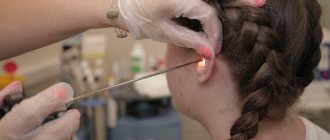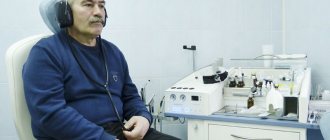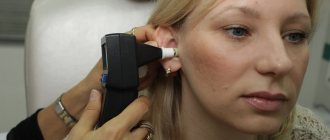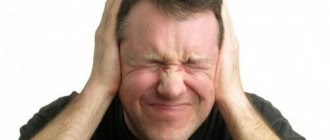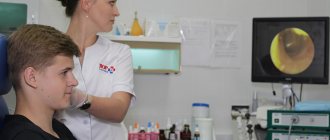Hearing problems in adults are not uncommon. Our ear is not an isolated organ; it is connected to other human organs and can react negatively to pathological processes occurring in them. Therefore, hearing loss and ear congestion may indicate various diseases. In some cases, the body copes with unpleasant symptoms on its own. If congestion and noise in the ear do not go away for a long time, when this condition accompanies the appearance of pain in the ear (although inflammation without pain can also occur), you should consult a doctor to determine the cause.
Causes
Clicking in the ears, not associated with swallowing, occurs when the muscles of the hearing aid contract. This occurs with muscle spasm, as well as due to swelling of the auditory tube. Swelling accompanies infectious diseases of the ENT organs (otitis of a bacterial or fungal nature, sinusitis, pharyngitis), Meniere's disease (fluid accumulation in the inner ear), habitual dislocation of the jaw. With arthritis and arthrosis of the jaw joints, patients are bothered by crunching and clicking noises due to damage to the cartilage tissue. Ear plugs lead to pronounced clicking sounds when swallowing, as the patency of the auditory tube is impaired.
Monotonous tinnitus occurs with high blood pressure. The cause may be not only chronic hypertension, but also stress, heat stroke and intoxication. Complex noises that are auditory hallucinations are often a sign of mental illness. In any case, no matter what reason the patient suspects, self-medication is not worth it. A timely visit to an otolaryngologist for diagnosis and treatment is the best solution if noise or clicking occurs.
Eustachian tube dysfunction
The Eustachian tube is the tube through which the middle ear communicates with the nasopharynx.
It has two openings, one of which communicates with the pharynx, and the second with the middle ear. The most important role of the eustachian tube is to provide protection to the hearing organs from bacterial or viral agents. The name comes from the Italian physician Eustachio, who discovered it in the 16th century .
The middle ear space is filled with air and is an area of the hearing organ that is blocked by the environment, except for a tube about 3 cm long called the Eustachian tube that opens into the back of the nose (nasopharynx). If the Eustachian valve does not open normally, the middle ear space is isolated and this can cause various symptoms.
When the Eustachian tube is functioning normally, whenever you swallow, yawn, or blow through your nose, your ear will “open.” This occurs because the eustachian tube is temporarily open, allowing air to pass through the middle ear from the back of the nose, which is open to the environment.
When this happens, there is a sharp and jerky unlocking sound (for example, when you are in a car that is moving down a high mountain). Yawning or swallowing causes contraction of the neck muscles, and as a result, the opening of the pipe opens slightly. Without the existence of the Eustachian tube, air circulation in the middle ear would be impossible, which in turn would be isolated from the atmosphere. This will result in a pressure difference and rupture of the eardrums (Perforation of the eardrum).
Some people have the ability to voluntarily contract these muscles, such as people who can move their ears. When this happens, your voice is heard louder. The involuntary opening of the pipe is considered a great advantage in situations that cause sudden changes in pressure, such as on air flights or in tall buildings. Additional pressure adjustment is made by opening the jaw slightly. The tube also opens when someone closes their mouth and nose and tries to exhale. In this case, the opening usually sounds like a soft sound and creates the sensation that air is passing through the Eustachian tube.
Why do I sometimes feel like my ear feels heavy?
Many patients have a similar complaint and describe it as "heavy ear", a feeling of pressure in the ears, a feeling of stuffiness in the ear.
In such cases, it is necessary to check whether the patient has wax plugs or other factors that may cause the ear to feel heavy or fluid in the ear. Most of these symptoms occur due to an inability to easily equalize pressure in the ears (or eustachian tube dysfunction) or the presence of some obstruction to the eustachian valve.
Why is there a feeling of fullness in the ears (and if the matter is serious enough, even constant pain in the ear)?
Because there is a pressure difference between the air pressure inside the eardrum and the external pressure. When a pressure difference occurs, the eardrum either swells outward (positive pressure) or inward (negative pressure).
The eardrum swells inward when the external pressure is greater than the pressure in the middle ear space (that is, for example, when a plane lands or you go deep underwater). The swelling of the eardrum causes a person to feel pressure in the ear. If the Eustachian tube is working correctly, once it returns to normal levels, the eardrum moves to a neutral position and the pressure on the ears is relieved.
Outward - when external pressure is less than the pressure in the space of the middle ear (that is, for example, when an airplane takes off or when driving along a high mountain). This situation is the opposite of what we mentioned above. Swelling of the eardrum causes the ear to feel clogged and clogged.
If the pressure difference returns to normal, the eardrum returns to its normal position. If the pressure difference is severe, the eardrum can swell to a dangerous degree and eventually rupture (a condition known as a pierced eardrum). People who suffer from negative pressure have an increased risk of fluid forming in the middle ear, which can lead to a middle ear infection (otitis media) and hearing loss.
What can lead to Eustachian tube dysfunction?
Very often there is a mechanical cause for Eustachian tube dysfunction, mainly in the nose, due to large adenovirus microbes (cloves). In rare cases, it may even be a benign or malignant tumor of the nasopharynx. Therefore, in patients with persistent Eustachian tube dysfunction, the baseline examination is for the presence of nasal and pharyngeal intracranial cancers.
Through introspection we can appreciate these problems. Very often, the Eustachian tube does not open properly due to inflammatory processes (chronic sinusitis), specific allergies (allergic rhinitis), which leads to persistent inflammation and swelling. This condition is known as an eustachian tube defect.
In some patients, the Eustachian tube is congenitally located much closer than in normal people. This is mainly due to genetic reasons or the pressure that is placed on the baby's head at birth. The result is the accumulation of large amounts of mucus in the middle ear, which can cause some degree of hearing loss. This condition is called secretory otitis (Link).
If the Eustachian tube remains open, how can you prevent Eustachian tube dysfunction?
Eustachian tube gape is the name given to a rare physical disorder in which the Eustachian tube remains open (its normal state is closed). This situation causes problems.
The result of this disorder is vibration of the drum during breathing, speaking, swallowing, and heartbeat. It creates an echo similar to when you put a bucket on your head.
Patients with a persistently open eustachian tube suffer from these symptoms throughout their lives, and unfortunately, there are no medications today that work well for eustachian tube dysfunction. The only solution in the current era is minimally invasive endoscopic placement of a tiny graft (cartilage) in the eustachian tube to improve its function.
Treatment:
Treatment always depends on the reasons that contributed to the development of the pathology. If the problem is due to hypertrophy of the adenoids (adenoids), treatment is usually surgical - adenotomy.
If the problem is due to eustachian tube dysfunction, treatment should be steroids and antihistamine nasal sprays for about 3-4 weeks. Throughout the entire treatment period, you should try to exhale forcefully with your nose and mouth closed (15-20 times a day), and also immediately after using the nasal spray. Yawning and swallowing don't help much.
Why do I hear a creaking or noise in my ear?
Sulfur plug
( Link ) or even a piece of hair may be at the top of the drum when the eardrum vibrates, this can cause friction or noise. Early treatment involves removing the foreign body from outside the ear canal. Eustachian tube dysfunction can also cause creaking or noise. The Eustachian tube produces mucus. Sometimes the surface may become sticky due to inflammation and thus any movement may cause squeaking or noise. Treatment in this case includes steroid nasal sprays, the treatment period is about 6 weeks.
Eustachian tube dysfunction , or temporomandibular syndrome, can cause noises that seem to come from the ear. The temporomandibular joint is located directly in front of the ear and can resist external noise and cause echoes in the ear.
The last possible cause of noise is muscle spasms of structures located in the ear (the stapes muscle or a tense tympanic muscle). The noise is usually described as a "clicking" sound and is not rhythmic. Repeats randomly approximately 1-2 times per second. This disorder is similar to eye twitching (blepharospasm) that occurs in some people. Unfortunately, the only treatment in this case is surgery.
Modern methods of treating eustachian tube dysfunction:
A fairly new treatment method is called endoscopic eustachian balloon dilation for the treatment of eustachian tube dysfunction. Basically, with the endoscopic method, they find the entrance to the Eustachian tube and insert a special balloon into it, which is then inflated. Thereby expanding the Eustachian tube, which leads to its normal functioning. The balloon is then deflated and removed.
Other causes of fullness in the ear:
- Cochleoneuritis.
- Meniere's disease.
- Sudden hearing loss (acute hearing loss)
- Sulfur plug.
- Serous otitis media.
- Large perforation of the drum membrane.
- Joint dysfunction syndrome.
- Acoustic neuroma.
- Severe laryngopharyngeal reflux.
First of all, it should be noted that such symptoms can be caused by various diseases, so every patient with symptoms of fullness in the ear and hearing loss should undergo a full examination by an ENT specialist (history, endoscopy, audiogram, tympanogram). This is necessary to make a correct diagnosis and determine adequate treatment. In some patients, ABR and/or even magnetic resonance imaging of the brain may be used.
Symptoms
If clicks in the ears are associated with swelling of the inner ear, then the ENT doctor will be able to objectively record them during the initial examination. Patients with inflammatory diseases of the ENT organs are also concerned about fever, congestion and pain in the ears (usually “shooting”), and possible ear discharge. With lesions of the jaw joints, patients complain of pain when chewing and a feeling of dislocation, often accompanied by an increase in temperature.
With tinnitus, against the background of high blood pressure, patients complain of weakness, headache, nausea, spots before the eyes. The skin of these patients is hyperemic, and convulsions may occur. With heatstroke, your body temperature rises, your pulse becomes rapid and weak, and your breathing becomes faster. These conditions require emergency medical attention.
When is it necessary to consult an ENT doctor?
Situations where unpleasant symptoms in the ear cavity go away on their own are rather an exception to the rule. If congestion and noise do not go away for a long time, hearing problems begin, if pain, nausea, dizziness and loss of balance appear - all this is a good reason to contact an otolaryngologist to determine the cause of this condition and prescribe effective treatment.
To determine the correct treatment tactics, a diagnosis is first carried out, which may include examination of the ear cavity, endoscopic, audiometric, and tympanometric studies. If necessary, a computed tomography scan is prescribed. In some cases, consultations with related specialists, for example, a neurologist, are required.
Depending on the diagnosis, a treatment regimen is prescribed.
Diagnostics
It is necessary to conduct a general and biochemical blood test to determine the presence of infection, a microbiological analysis of a smear from the ear and nasopharynx. An ENT doctor examines the level of hearing and the patency of the auditory tube. X-rays and MRIs can determine the presence of inflammatory diseases, lesions of joint tissue or neoplasms; An ultrasound is performed to determine the condition of the hearing organs. In case of hypertension, blood pressure and ECG measurements are required. In the absence of physiological changes leading to tinnitus, consultation with a psychotherapist is necessary.
Treatment
It is clear that due to various reasons for the appearance of noise, treatment methods can vary significantly in each case. If the clicking in the ears is caused by the presence of wax plug, it is removed in a hospital setting. In the presence of infection, complex antimicrobial therapy is carried out - antibacterial or antifungal drugs, antihistamines (Diazolin, Suprastin, Loratadine) and vasoconstrictors (Otrivin, Naphthyzin, Polydexa), non-steroidal anti-inflammatory drugs (Nurofen, Ibuprofen). In case of severe muscle spasm, muscle relaxants (Drotaverine, No-Shpa) are prescribed. For lesions of the jaw joints, it is recommended to take chondroprotectors (Glucosamine, Chondroitin).
The accumulation of fluid in the inner ear requires the prescription of antipsychotics (Aminazin, Triftazin) to normalize the functioning of the vestibular apparatus and diuretics (Diacarb, Veroshpiron) to reduce the level of edema. Pneumomassage of the eardrum, performed by an otolaryngologist, is also indicated. Tinnitus with hypertension requires treatment of the underlying disease. To normalize blood pressure, beta-blockers (Anaprilin, Metoprolol), sedatives (Persen, Novo-Passit), ACE inhibitors (Captopril, Lisinopril, Ceronapril), calcium blockers (Nifedipine, Manidipine), diuretics are prescribed.
If tinnitus reduces the patient’s quality of life, along with drug therapy, the use of psychological techniques may be recommended to reduce the severity of subjective perception of noise.
The reception is conducted by specialists
Kirillov Evgeniy Sergeevich
Audiologist
Cost of services
Initial consultation with an audiologist
1200₽
Repeated consultation with an audiologist
1000₽

